Introduction 4b
Progressive Thinkers as of 5/8/2020

| page 1 intro | page 2 intro | page 3 intro | page 4a intro | page 4b intro | page 5 intro |
| page 1 | |||||
| page 1b | page 1c | page 1d | page 1e | page 2 | page 3 |
| page 4 | page 5 | page 6 | page 7 | page 8 | page 9 |
| page 10 | page 11 | ||||
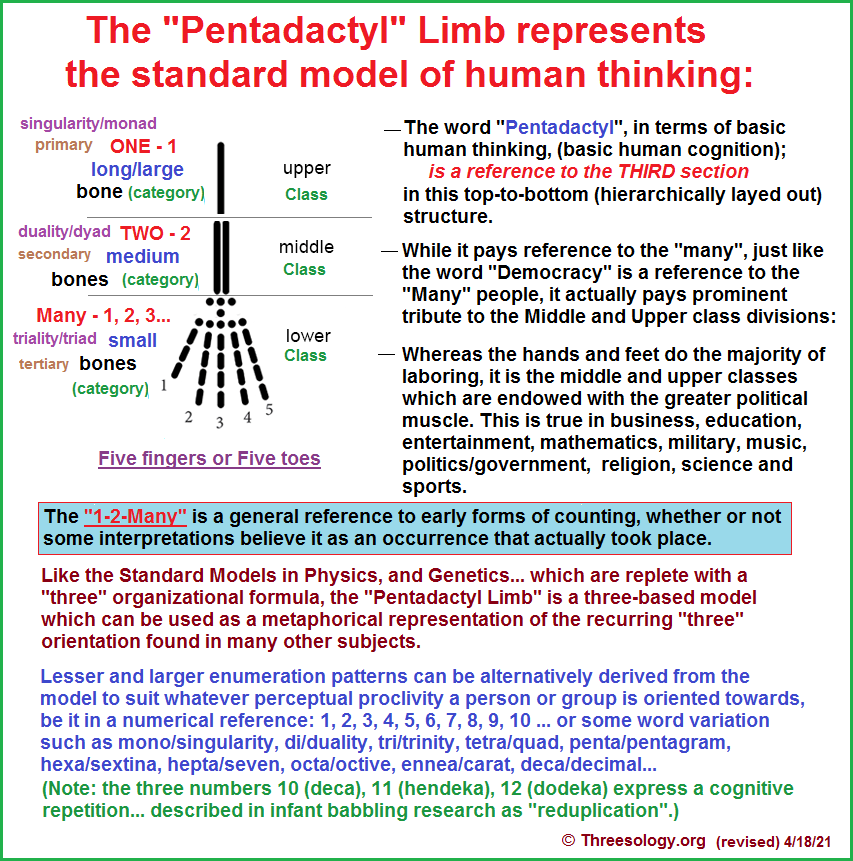
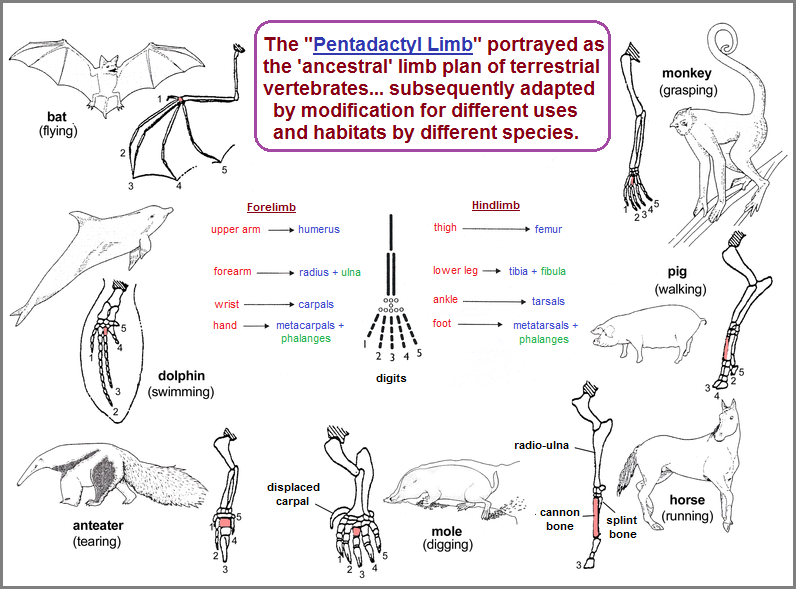
...Continuing from the previous (4a) page:
- The words "singularity, Uni-verse, existence, space, time, gravity, vacuum, consciousness, fusion..." can be viewed as references to the quantity of "1" (when viewed as singular identities).
- The words "reversal, loop, emergence, space/time, gravity/vacuum, conscious/non-conscious..." all imply some measure of duality (as items viewed either as a complementary, complimentary, contradictory, parallel, series, teeter-totter, swing—to/fro, merry-go-round association) which are a quantity of "2".
- The words "Universe, time, space, consciousness" (as whole-istic containment vessels), "multi-dimensional, quantum", can be viewed as compartmentalizations of the 'much, more, and many' themes.
Yes, the same words or phrases (in different instances) can be shoe-horned to represent singles, doubles and multiplicity, with "multiplicity" being used to describe any value beyond two. For example, we see life forms with one cell and call them Unicellular, but no specific life form with two cells and no life forms have been found to exhibit only 3 cells (at least not in my cursory search attempts). However, there has been discovered an organism called the "happiest alga" (Tetrabaena socialis) which is thus far is the simplest multi-cellular in the Eukaryotic realm. It is described as having a four-leaf clover shape.

Colonial volvocine algae or colonial Volvocales constitute a robust monophyletic group composed of three families, the Tetrabaenaceae, Goniaceae, and Volvocaceae, and Tetrabaenaceae is the most basal group suggested by morphological and molecular data (Figure 1).
The Tetrabaenaceae was established by Nozaki and Ito and includes two four-celled species Tetrabaena socialis and Basichlamys sacculifera. T. socialis has four Chlamydomonas-like cells arranged like a four-leaf clover (Figure above) and swims with its flagellar bases orienting forwardly as the colony rotates. The four cells constitute a square vegetative colony by the connections of their extracellular matrices (ECM: extracellular matrix). The transition to multicellularity in the volvocine algae occurred about 200 million years ago in the Chlamydomonas-like ancestor. (The simplest multicellular organism unveiled.))
Like the use of a binary system (zeros and ones) in computer language based on the on/off designations used for an electrical circuit, we also find this "twoness" being used in cell division as well as in Astronomy when "binary" star systems are frequently referenced. When such occasions arise in my search for the otherwise seemingly ubiquitous presence of patterns-of-three, one can not simply reference "threes" as "THE" dominant theme, unless we move into a discussion of what may be tentatively called "proprietary domains" where different number patterns are allocated a separate place and thus represent a larger configuration within the context of human-perceived existence. Such proprietary occasions remind me of the organelles of a cell, where they exist in their own realms next to one another within a cell and typically occupy a separate task, though those tasks may overlap. Hence, we can have different cognitive patterns but they all fit together in an assemblage which present day psychology, mathematics nor any other subject has come to appreciably deduce to the extent of formulating at least a preliminary scaffolding of a standard (cognitive or other-named) model.
Presently, since life forms are found to exhibit either one or several cells, we have the two-patterned one/many designation reference as single and multi-cellularity. The "multi" is akin to the "many" designation being used in the present discussion involving the usage of enumeration for identifying observations of humans in different contexts, as if life is using a very simple counting sequence involving an elaboration of pairing... according to the perceptions of many humans living in the present era. Whereas in one era it may be standard to claim the perception of a one, two, or three-patterned structure, a later human era may compound such patterns into multiple organizational themes. In other instances this is reversed, such as in the case when early peoples worshipped multiple gods but later eras come to accept the Jewish insistence of a singular god who views the Jews as a special people. Human ego frequently comes into play to alter some perceptions. An example of this is when a local club or team is described as a "world champion" though the contest they were involved with only included those from a rather small territory, and has nothing to do with the world beyond the obsession of those involved in a given sport. Such perceptions have a very limited counting base.
Upon finding a small handful of different enumerations being used in different subject areas referencing research of Natural patterns (in Physics, in Biology, in Sociology, etc...), does this mean Nature itself is engaged in a rudimentary form of counting just like that observed in life forms such as birds? Is Nature in the existence which humans occupy a "simple organism"? Can all of nature evolve into a more complex life form? Or is the simplicity being observed (occasioned by the cataloguing of enumerations being used by humans); an expression of a type of simplicity in the present era of human thinking?
Human observations of animal life forms doing different tasks, suggest that at least some non-human life forms engage in what appears to be a rudimentary form of counting. At least that's what we call it. And those supposed behaviors of counting suggest a type of cognition that is more complex, or at least originates from a particular physiological (cellular) complexity, that some might want to venture as expressions of an "emergent" property such a pre-consciousness that need not be aware that humans define some of their mental activity as consciousness. In other words, a bird engaged in what we humans perceive to be a basic or rudimentary counting activity is a step in mental development that comes before some type of bird consciousness... unless some or all birds (if not all life forms) [metaphysically speaking] have a type of consciousness right now. Some armchair or curbside philosophers might well consider that all of existence is a consciousness and we humans are but a miniscule spark between the neurons of the Universe. And just as humans are not typically conscious of its own brain's neuronal firings amongst themselves, the Universe may well have a consciousness that is not aware of humanity or even life as we know it.
Human consciousness, though using a variety of three-patterned orientations to describe Natural events (ie. 3 laws of motion, 3 laws of planetary motion, triplet code in DNA/RNA, geodesic triangulation, three families of fundamental particles, etc...), relies heavily on a two-patterned orientation influenced by Mathematics absorption with using patterns-of-two such as the already mention add/subtract, multiply/divide, positive/negative, rational/irrational numbers, etc... Similarly, we find this in physics with its reliance on a particle/anti-particle theme, though there is the established view of three particle families. Mathematics is static. It is not evolving beyond its rather obvious obsession with a two-patterned orientation established centuries ago, for which many a person might well argue that the use of dichotomization is a natural fact of logic which we used in the development of computers. However, it is not that dichotomization is not noted as being applicably useful in our human lives as they are currently being lived, it is that patterns-of-two are not being recognized as being a part of an enumeration ensemble that is most difficult to see if one does not take a look at a variety of subjects to notice that all of them are using a small stock of similar enumerations which are either characteristic of the objects under investigation or are a by-product of the type of consciousness humanity is accompanied with as the type of life form which it is.
We humans come to rely upon mathematics as a means to navigate reality of nature and natural phenomena as well as the convoluted realities created in the imaginations of individuals as well as that resulting from a collection of mish-mashed imaginations from which a society arises and comes to believe is the one true reality instead of an exercise being practiced by an over-bearing institution such as a business, government, or religion. Because humanity is not recognizing similar patterns of cognitive disposition being used in different subjects, and that these dispositions are but a handful of possibilities; humanity is overlooking that the re-usage of a small quantity of numerically identifiable patterns suggests humanity is being subjected to pressures which cause it to comply as a presumed survival mechanism. However, the survival is an illusion since the larger planetary events are headed along a course of incremental deterioration. As such, the so-called survival mechanisms being used are in fact rationalizations created to cope with a situation that the human species may, on a subtle level of perception, recognize as a trek towards obsolescence. It is a coping mechanism much like any number of intoxications and distractions one uses on a day-to-day basis and convolutes into some approximated belief that the way they live is the reality best suited for the conditions under which they permit themselves to adapt to.
If one religion exchanged its beliefs to another religion, then the lifestyles of the believers would change accordingly. For example, if all Islamic models of religious believers adopted some Christian model of perception, and all Christian models of religious believers adopted some Buddhist model of perception, each of them would alter their societies in accordance with what they believed was the truth. Likewise, if one business model changed for another kind and one government adopted a different model of government... they too would create environments in which those involved would eventually apply their music, mathematics, eating habits, spending habits, policing policies, incarceration views, child rearing philosophies, Nationalized medical treatments orientations, etc... according to the practiced dispositions of a given set of presumptions of what is best, true, and representative of the kind of equality which is accepted as conventional. In other words, we can plainly see how the human mind can adapt itself to prevailing perspectives under which one is occasioned to live in accordance with. The human mind has great flexibility and yet when we look at the basics of different subjects, we see a recurring small quantity of number patterns being used to describe basic plans, processes, procedures, proposals and overall perceptions that are arguably due to the type of physiologically defined abilities of the human species to conceptualize the existence of Natural phenomena. And even if one claims their ideas are wholly different by being opposite, they do not recognize that such a practice of opposition is just another example of a conceptualized dichotomy that some might transform into a trichotomy or multiplicity, yet do not recognize their efforts to appear to be wholly different are but another example of the small set of conceptual models being used and more easily recognized by an applied enumeration which reveals the repetition, despite attempts to create the ego-initiated view of presenting a substantial difference by using language as an act of camouflage, whether intentionally or unconsciously invoked.
In order to identify the similar cognitive patterns being used in different subjects, one must delve deep into the convening views but not get entrapped in them to the extent of becoming disassociated from the primary task. It is like an undercover police officer who must be able to walk away from the type of life they had to adopt while investigating an organization, and regain their footing of where they came from; even if the lifestyle of that which they became involved with during their investigation was appreciably more lucrative in many respects. Whereas becoming involved with the minutia of a given subject might well create the situation of one becoming a sought-after expert where a standardized job was offered, typically what occurs is that one's own research interests are forced to be place aside in order to perform tasks assigned to them by a person involved with a parent organization's singular interests which may not include the researcher's, though this was not seen prior to an accepted employment, nor the subterfuges which may be employed in order to get a give researcher to align themselves with an organization attempting to garner some measure of prestige from the reputation of a researcher.
Because one can cite exceptions to the pattern-of-three profile being used as a regularly occurring cognitive displayed pattern, we must identify all the different patterns and sort them as a group. In some instances one may find a recurring number such as an Astronomical event occurring every 26,000 years, and yet not find this number being used elsewhere. Let me reassert, that in the present era of humanity there are only certain patterns (which can be enumerated) that are being perceived. Whether this dramatically changes in the future is not known, but we must make an effort to catalogue those patterns which we of today can perceive. While some may claim there exist patterns which can not be reduced to enumeration, how many of what kinds are there? Do you use words such as many, lots of, or hundreds to propose a quantity, and yet do not actively make an effort to count the presumed perceptions of patterns claimed to be so very different which makes them incapable of being enumerated?... and yet, enumeration is itself to be an enumerated item of usage.
In some venues I see someone illustrate or make a comment about a given enumerated pattern, but if I then comment that such a pattern exists in other subjects, the account of such a correlation may be frowned upon as if I was making an attempt to discredit a view that was being held up as a unique item to be perceived. By expressing the opinion that a given perception is similar to other perceptions found in a variety of places may well be interpreted as belittling a perception regarded as a special quality of a given belief. Take for example (again, since I have used it several time before), the idea of the Christian Trinity, Hindu Trimurti and numerous other three-patterned religious ensembles found in history as representative of a recurring cognitive theme that is expressed in different ways in different cultures over time, and yet the origin of such views followed sometime on the heels of the religious (called Pagan) orientation of the Sun's three phases (or "moments") called dawn-noon-dusk. Whether there was a three-patterned influence of why people latched on to the Sun, is not yet identified, unless one claims the psychology is due to a three-patterned anatomy due to a three-patterned genetics due to a three-patterned atomic structure.
From one generation to the next and from one culture to the next we can encounter illustrated changes of similar perceptions whose labeling and application may give the appearance of an appreciable difference which does not in fact exist. Indeed, even within one's own country, state, province, or country can be found sometimes small or at other times declared large differences in an interpretation or definition thereof. If we had no references between the U.S. and Metric systems of measurement, the two might well appear to be different models of thinking without any basis for equality. While the use of the metric system is an attempt to be "scientifically" more accurate, many U.S. Americans (and others) prefer the feet, inches and miles orientation instead of resorting to millimeters, centimeters, and meters. Even the British use the conventions of measurement though both the U.S. and Britain have largely adopted the metric system for containers and quantities of gasoline (petrol), as well as incase of displaying both miles and kilometers on dashboard speedometer gauges. The point is that there is an attempt by humans to practice a system of weights and measures to establish a system of uniformity, just as can be seen in the development of life forms, which includes the uniformity of perception that there are a multitude of different life forms. Hence, the use of the word "multitude" is a "many" cognitive reference.
Although Ernst Haeckel created a larger listing of developmental embryonic stages, the following smaller sample clearly indicates similarities of development occur with different life forms. While adult forms may show similarities like have two ears, two eyes, one head, etc. it is by back-tracking from the later adult expressions of development that we can recognize a similarity in origin.
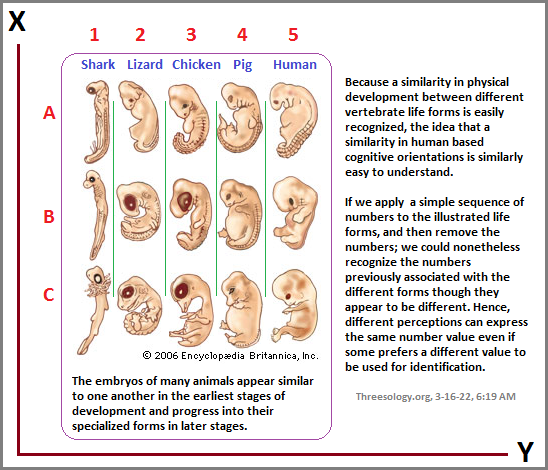
Later and larger forms are later and larger developmental formulas which might be used by some observers to claim that there are more differences than similarities between two or more life forms, just like some readers might view the quantity of a trillion greatly different than a quantity of a hundred. Whereas one hundred is a large number when compared to all numbers less than itself, it is small in comparison to a larger number such as a Trillion, though it too is small in comparison to a googolplex.
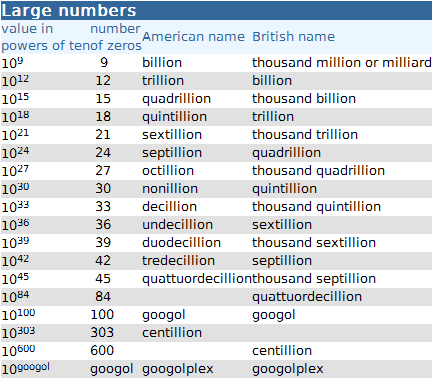
Indeed, if one views gigantism as "THE" defining characteristic of a life form, just as one who might claim a given number is relatively "gigantic" in its value based on one's personal interest in it, then not only will other patterns not be paid much attention to nor the presence of a pattern when all numbers are considered together. Establishing the idea for the existence of a standard model in thinking is a question of measurement. It is a study in itself, as described by the following excerpt from a Britannica article entitled "Measurement".
Measurement theory
Measurement theory is the study of how numbers are assigned to objects and phenomena, and its concerns include the kinds of things that can be measured, how different measures relate to each other, and the problem of error in the measurement process. Any general theory of measurement must come to grips with three basic problems:
- Error;
- Representation, which is the justification of number assignment;
- Uniqueness, which is the degree to which the kind of representation chosen approaches being the only one possible for the object or phenomenon in question.
Various systems of axioms, or basic rules and assumptions, have been formulated as a basis for measurement theory. Some of the most important types of axioms include axioms of order, axioms of extension, axioms of difference, axioms of conjointness, and axioms of geometry. Axioms of order ensure that the order imposed on objects by the assignment of numbers is the same order attained in actual observation or measurement. Axioms of extension deal with the representation of such attributes as time duration, length, and mass, which can be combined, or concatenated, for multiple objects exhibiting the attribute in question. Axioms of difference govern the measuring of intervals. Axioms of conjointness postulate that attributes that cannot be measured empirically (for example, loudness, intelligence, or hunger) can be measured by observing the way their component dimensions change in relation to each other. Axioms of geometry govern the representation of dimensionally complex attributes by:
- Pairs of numbers.
- Triples of numbers.
- N-tuples of numbers. (H.O.B. note: That is, "many" numbers.)
The problem of error is one of the central concerns of measurement theory. At one time it was believed that errors of measurement could eventually be eliminated through the refinement of scientific principles and equipment. This belief is no longer held by most scientists, and almost all physical measurements reported today are accompanied by some indication of the limitation of accuracy or the probable degree of error. Among the various types of error that must be taken into account are errors of observation (which include instrumental errors, personal errors, systematic errors, and random errors), errors of sampling, and direct and indirect errors (in which one erroneous measurement is used in computing other measurements).
Measurement theory dates back to the 4th century BC, when a theory of magnitudes developed by the Greek mathematicians Eudoxus of Cnidus and Thaeatetus was included in Euclid's Elements. The first systematic work on observational error was produced by the English mathematician Thomas Simpson in 1757, but the fundamental work on error theory was done by two 18th-century French astronomers, Joseph-Louis Lagrange and Pierre-Simon Laplace. The first attempt to incorporate measurement theory into the social sciences also occurred in the 18th century, when Jeremy Bentham, a British utilitarian moralist, attempted to create a theory for the measurement of value. Modern axiomatic theories of measurement derive from the work of two German scientists, Hermann von Helmholtz and Otto Hölder, and contemporary work on the application of measurement theory to psychology and economics derives in large part from the work of Oskar Morgenstern and John von Neumann.
Since most social theories are speculative in nature, attempts to establish standard measuring sequences or techniques for them have met with limited success. Some of the problems involved in social measurement include the lack of universally accepted theoretical frameworks and thus of quantifiable measures, sampling errors, problems associated with the intrusion of the measurer on the object being measured, and the subjective nature of the information received from human subjects. Economics is probably the social science that has had the most success in adopting measurement theories, primarily because many economic variables (like price and quantity) can be measured easily and objectively. Demography has successfully employed measurement techniques as well, particularly in the area of mortality tables.
While most social theories are speculative, like so much of philosophy and many parts of mathematics as well as theoretical physics, this is largely due to sampling and lack of an analogical frame work to put a given idea into a measurable scaffold of basic attributions. In other words, a given idea isn't placed into a box whose dimensions are understood in terms of measurement because sociology, like literature and other subjects, do not come in boxes but various wrappings which are tossed aside like an eggshell or cacoon, and attempts to introduce associated items which can be measured, are viewed as points of discussion which create the impression a person doesn't understand Sociology, at least not as it is being taught as an art form and not the formerly suggested tool of science which its founders thought it would be in order to facilitate productively useful changes in society to benefit everyone.
If we take one aspect of sociology and analogically apply it to a model from a different subject are which can be quantified, then Sociology begins to yield up its basic patterning as well, despite attempts by those who prefer that it not be measured in order to exhibit the limitations of a give social order or the limitations of those selected to create conditions for improvement. However, the usage of number references can be used to create conditions of greater inequality or by producing a system which sets up quotas that enable incompetence to gain a position of social leadership whereby standards of actual competence are lowered to enable more idiots to garner leadership positions from which no actually useful legislation or leadership are obtained. The overall society does not improve, only the lifestyles of an incredibly dumb minority.
By using an anatomical illustration such as the Pentadactyl limb to reference an already established hierarchical structure occurring in Sociology such as the upper, middle and lower social classes; one can both analogically and metaphorically describe additional attributable correlations. For example, the upper class is not only correlated with the large single arm and leg bones with their large muscles, but describe the upper class as having more "political muscle" than either the middle or lower classes, as society is practiced today. Equally correlative is the fact that most people harbor the lower class of society which is compared to the many more bones found in the bones of feet, a count of 106 which is more than half the entire skeletal count of 206 bones. Additionally, like the hands and feet, the lower class does most of the work. However, measuring what actually is meant by a lower class might cause some interpretations to claim a proportion of the Middle class should be considered also a part of the lower class, whereby we have an increasing segmentation taking place with the three traditionally allocated class divisions (based on economics), thereby creating a multi-leveled hierarchical structure reminiscent of a clothing sizes rack in a department store with X, XX. XXX- size divisions for the traditional small- medium- large sizes which often look like a genealogical or tree diagram of a biological taxonomy such as can be created from the following list of hybrids:
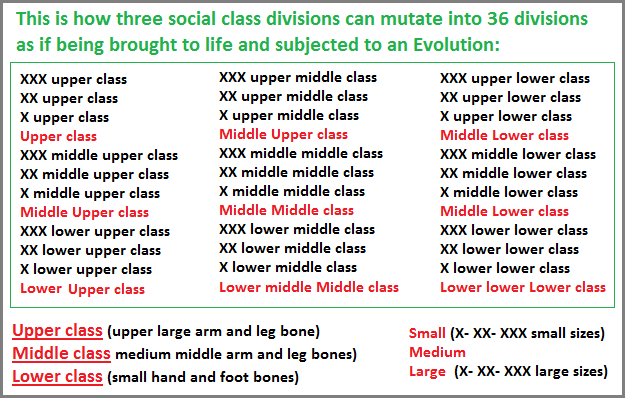
Date of (series) Origination: Saturday, 14th March, 2020... 6:11 AM
Date of Origination (this page): Tuesday, 8th March, 2022... 4:39 AM
Date of Initial Posting (this page): Wednesday, 16th Marchm 2022... 2:24
